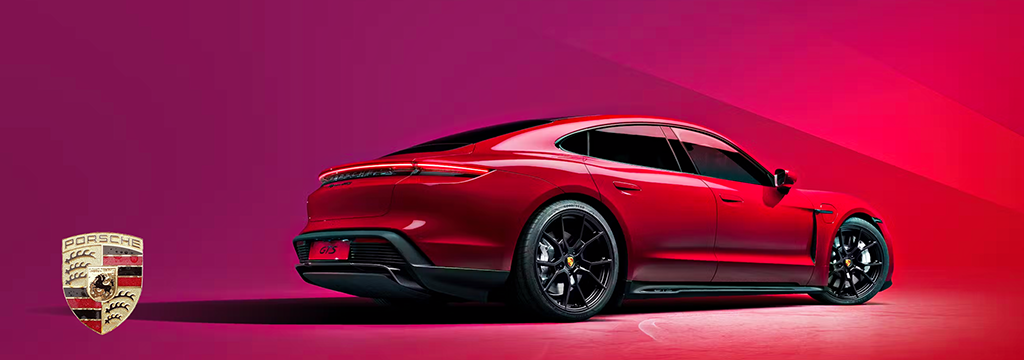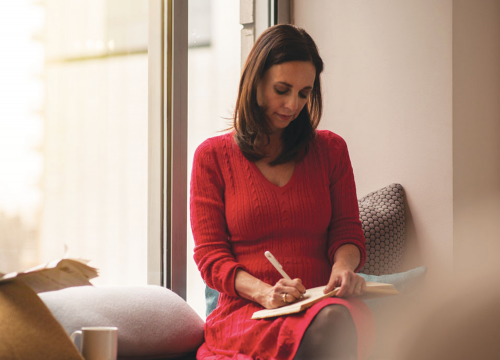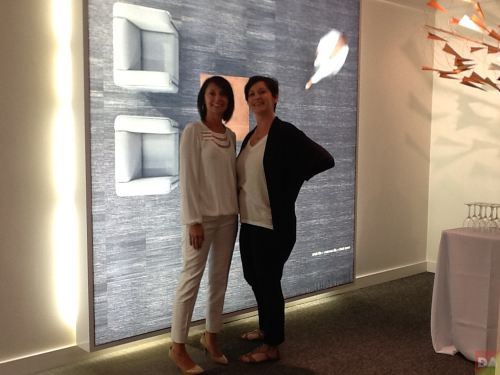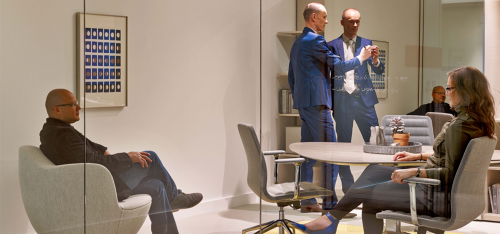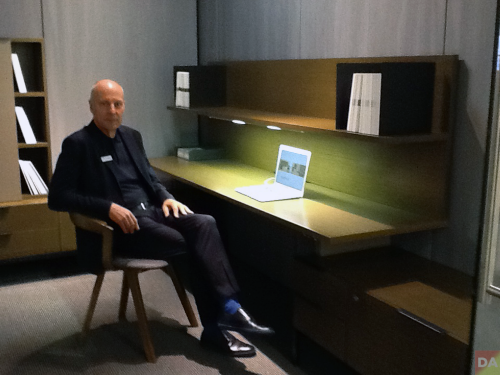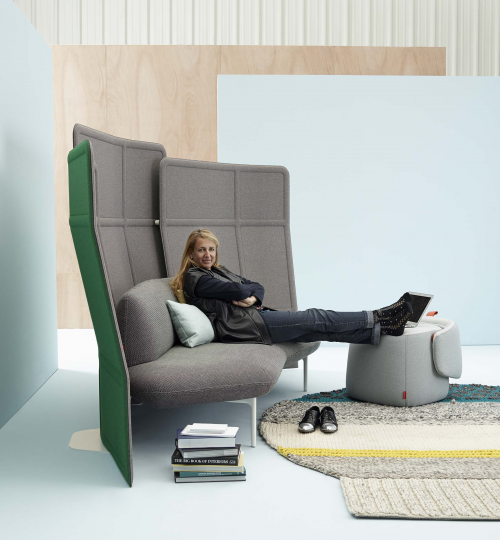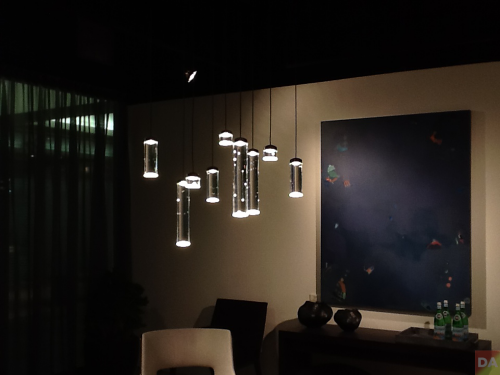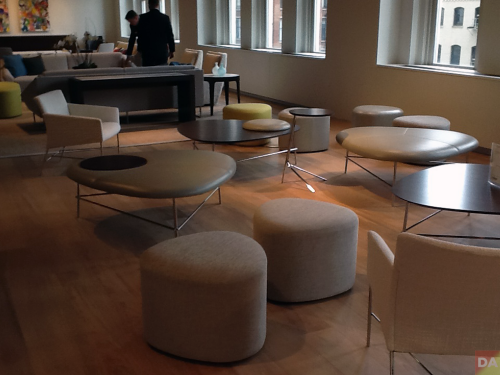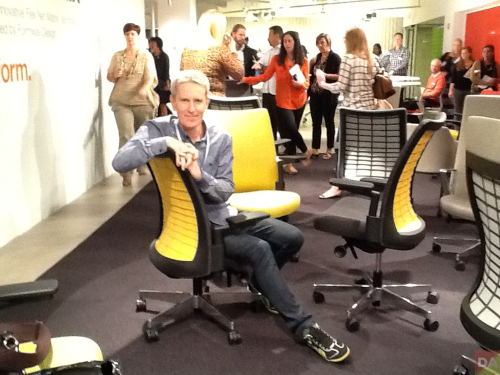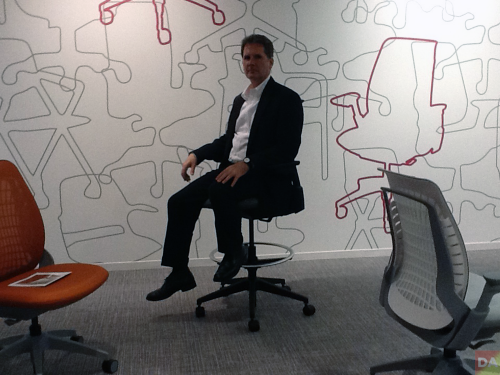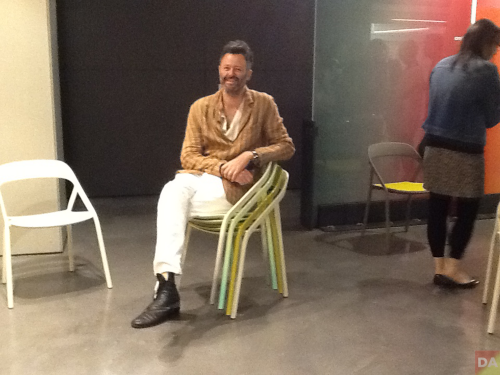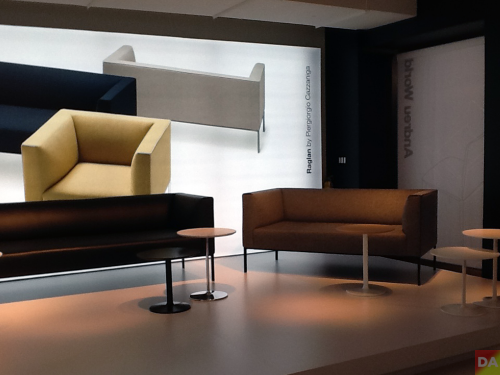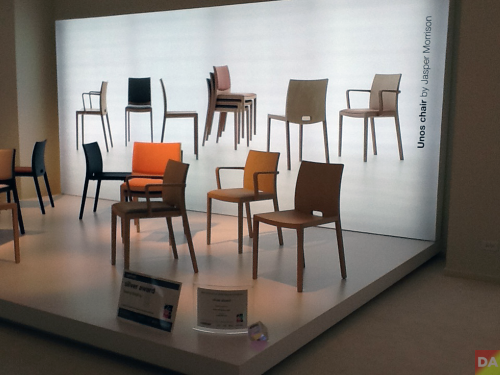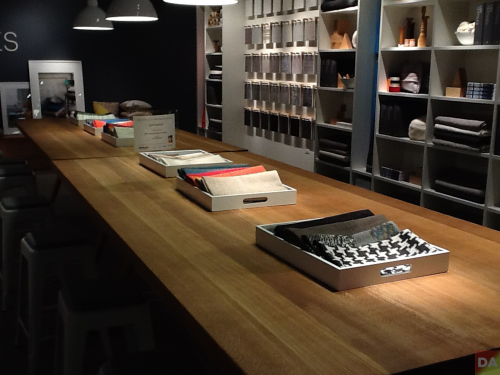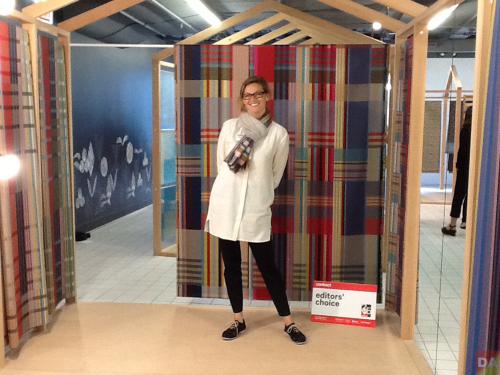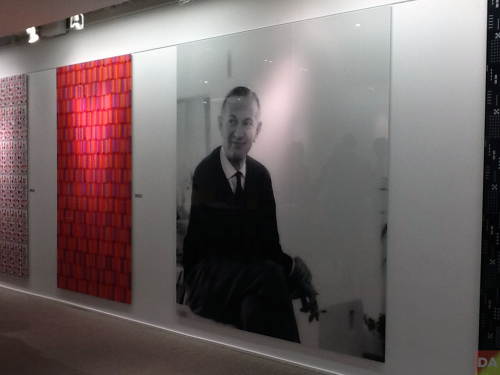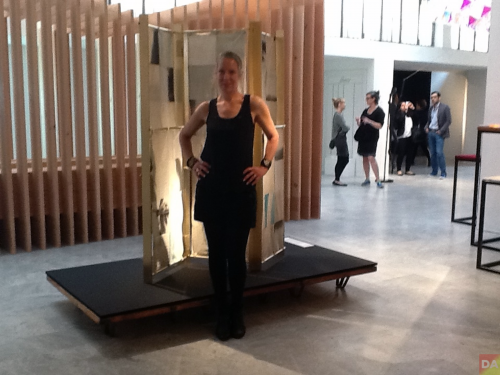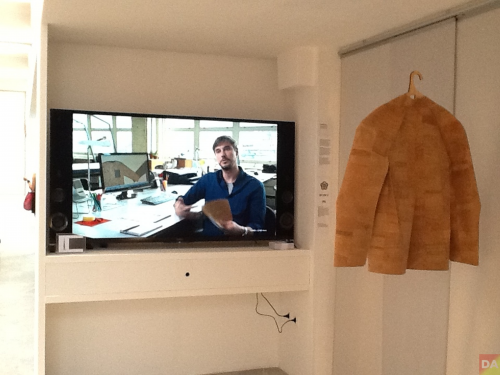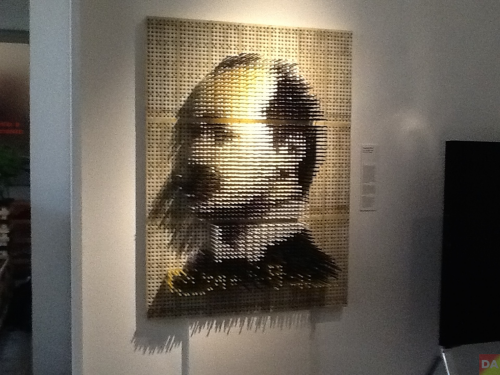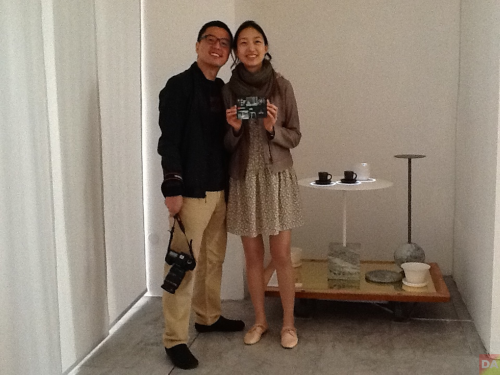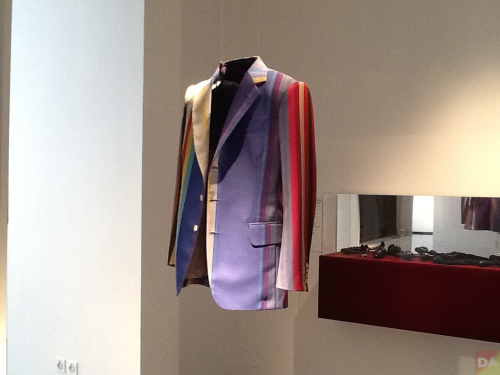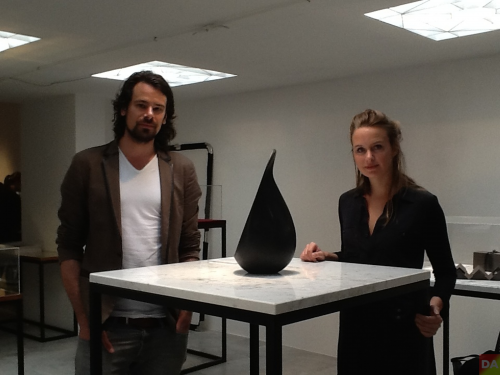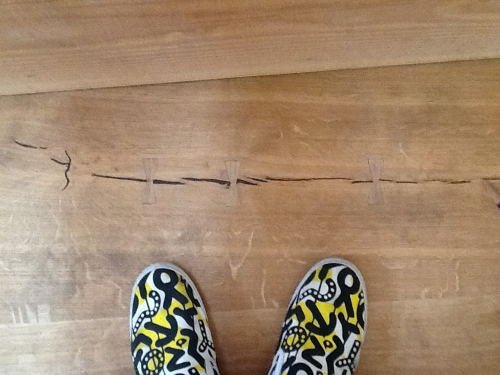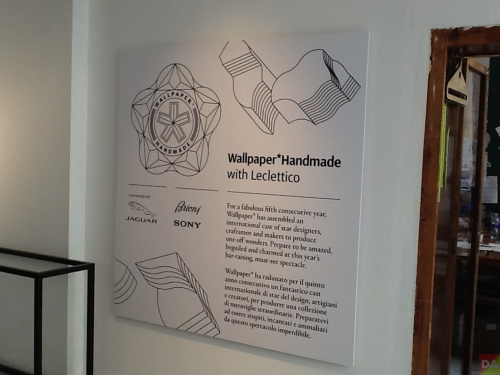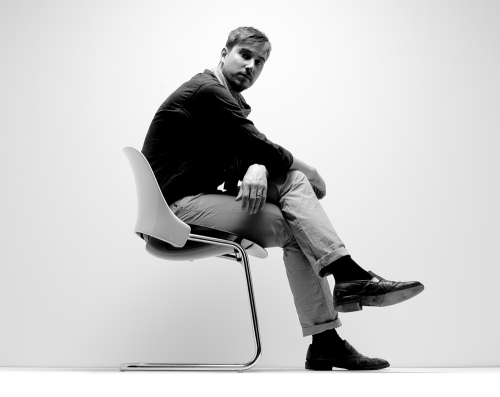 todd bracher sitting on humanscale’s “trea” [click on photo to enlarge]
todd bracher sitting on humanscale’s “trea” [click on photo to enlarge]
It’s Tuesday, 14 June, Flag Day. We’re talking to Todd Bracher in the Chicago showroom of Humanscale.
[DesignApplause] Todd, give us a little idea of what your work environment is like.
[Todd Bracher] I’d say my work environment is quite neutral. I’m based in the Brooklyn Navy Yard, which is sort of a barren part of New York City, which is quite a contrast in its own right. It’s almost like working on a sailboat. You have views onto the harbor and to the East River. It’s wonderful. But what I love about it is the large, open, industrial-like space, really neutral, no outside influences around me. In other words, I look out the window and I see the water and the sky and for me it’s just a white slate. It’s a wonderful place to think and not be influenced by anything.
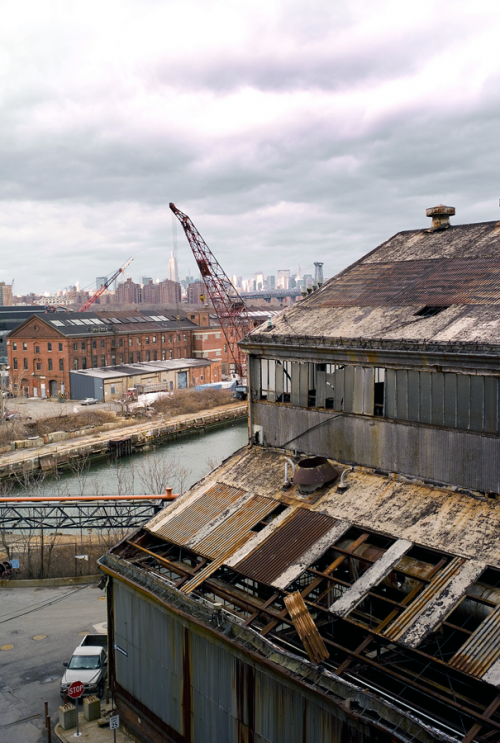
view from workspace
I don’t know if our process is unusual or not. We research and study nature, for example natural selection, and we talk a lot about Darwin and how nature finds the ultimate solution. It’s similar to baking bread. We know we need certain ingredients. We put all of the ingredients together and start to bake this bread. And we know that if we throw any of the ingredients away it won’t be just right. At the end of the day we pursue the most efficient solution based on market and client needs.
[DA] What kinds of things are you working on, what do you create?
[TB] This may sound cliche but we’re out to make real-world solutions and we’re not interested in just making beautiful objects. It will be beautiful but it has to sell, it has to be smart and useful for people. We work on a variety of things. From “Trea” for Humanscale which is intended to be a higher volume light task chair all the way to lounge seating and lighting. It’s a broad spectrum from creative direction to branding to final product production.
[DA] Your youthfulness belies remarkable accomplishments. You have a decade of experience working in Copenhagen, Milan, Paris and London; cited as America’s next great Designer and nominations for Designer of the Year in 2008 and 09. You headed Tom Dixon’s design studio, and the creative director at Georg Jensen. Does the head get in the way?
[TB] Are we talking about ego or too much stuff in the head?
[DA] Let’s talk about both.
[TB] If anyone thought I’m about ego then they don’t know me. At the end of the day I’m part of the tool. I am a collaborator. I bring my two cents in but the company has their part as well as the manufacturers and the guys in the workshop. The sales team has there part and everyone everywhere has their part and I’m just a cog in the wheel. And everyone is doing what they’re good at. I’m happy to be the face of the product but I’m not the only one involved.
[DA] What’s the genesis of you work? Does a client call you in and ask you to design a chair? How does it work?
[TB] It works in different ways. With Humanscale I had a conversation with Bob, the CEO and he basically said “make me something that’s cantilevered, make me something really smart, make me something beautiful. And it was sort of that casual. A very European way to approach it, while other clients bring a long brief, 10 pages long. But the first thing we do is we go out and do the homework. We find out what the market is looking for, what it needs, how it uses this or that in actual applications. It doesn’t start with drawing, it starts with research. We also pay attention to the psychological side, how people are attracted to the object. Finally we start drawing and building mockups which leads to final development. But it’s a long front-end of research.
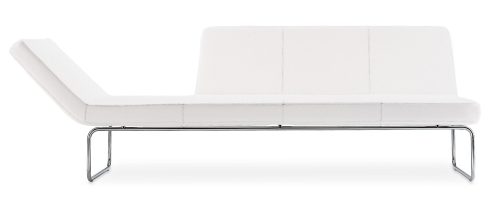
freud | zanotta | 2002
I guess my earliest motivations was the a chance to be a bit selfish, to absorb myself in design. And I guess I learn more by doing rather than by reading. I had finished an undergrad degree in Pratt in 1996 and started designing consumer products for the U.S. market working for another designer. It was a remote caddy, spice racks, barbecue tools, these kinds of products. It made sense at the time but I wasn’t satisfied. I wanted poetry and artistry that went with it. I wanted concept and more meat to the bones. So I applied for a Fulbright grant and I ended up in Copenhagen, which gave me the wonderful chance to study Danish design. Young American designers, we tend to learn through studying books but in Copenhagen you can go directly to the factories, go visit the actual production that’s happening around the world. I spent two one-half years in Copenhagen and completed the master’s course. Then I went to Milan and started designing for Zanotta and a few other brands and ended up in Paris and then also London for Tom Dixon before coming back to New York. This first-hand experience gave me the tools I hope I need to design.
[DA] In Metropolis magazine you say the European manufacturer can be more spontaneous when giving you an assignment as compared to the U.S. manufacturer. Can you elaborate?
[TB] It’s more or less true though there are reasons for this difference. For the scale of the work that’s done in the U.S., for the difficulty of the task, it’s a much more complicated process. And to do it in a two-year timeframe versus a less complicated European one-year timeframe, I think the design teams here are faster actually. The difference for me may be European business is more emotion driven, it’s more about what you feel plus your direct connection with the owner where together you create something you both feel good about for that year and you see where that goes. It’s also not the long-term plan for most of the European companies and it’s more visceral, more from the hip. The U.S. is more of a marketed-to culture, less about the heart and more to where it’s going, what’s the business part, what’s it for. But it doesn’t mean it’s not beautiful, it doesn’t mean it doesn’t have meaning. At the end of the day it’s still a wonderful, beautiful product that’s well-considered.
[DA] What do you think about products that are designed to be polished and built to last versus products that are designed to be quickly disposable?
[TB] That’s a very broad question. I don’t really make anything that’s disposable. Even if it’s a plastic lamp it’s not made to be disposable. There are of course disposable products in the world, but I don’t intend to work in that world. Though I feel compared to Europe the U.S. is not disposable, most products are in fact built to last. Whereas a European mindset is what’s working and interesting at the moment and where it goes after that is a little less regarded. It doesn’t mean it’s not important but most European companies don’t depend on the product which sometimes works to their advantage and sometimes it does not.
[DA] Who or what inspires you?
[TB] What inspires me are things I could never do myself. For me to go to, let’s say the Museum of Natural History, and to study the life cycle and evolution of fish, for example, is absolutely brilliant and that inspires me. Not furniture, not something I could have made myself.
[DA] There isn’t a day that goes by that you’re not inspired. Right?
[TB] Ha! Well it’s one thing to be inspired and another on how to capture that which has an influence on what you’re doing. And that might happen once or twice a year if you’re lucky.
[DA] What are some of the characteristics of your work?
[TB] I guess you can say “efficiency” which may sound sort of boring but there’s a lot to it. There’s what I call “engineered aesthetics” where we’re making something that’s extremely beautiful but it’s also really purposeful. It’s not just about its beauty. The “Trea” chair for example is all about its reduction. Reducing materials, reducing everything to its bare essential but not letting it get cold and lose its sensual qualities. And at the same time you don’t see the springs and knobs and all those things that make an ergonomic chair comfortable. We’ve done away with all of that and made the mechanism internal. It’s all about boiling down the solution while maintaining the emotional qualities.
[DA] We recently purchased two Eames Sofa Compact benches for our living room. It amazes me that the solution in 1954 was you see all the bolts and springs and it’s so simply put together and yet something very charming. You are reminded of the limited technology.
[TB] For sure. And indirectly we have a similar solution on our “Trea” chair where you see how the back attaches to the seat, you see the seat, you see how the leg attaches, we’re not hiding that. But you don’t see the springs and the screws that make the chair work. It’s a balance between the two.
[DA] Has your style changed since you started? Has it always looked this way and you’re simply refining things?
[TB] It’s been pretty consistent. I’d like to think I keep using this reference that it’s like a tree, and our results are how a tree grows. You would never say that tree doesn’t look very nice, or that branch is in the wrong place. You can’t have an opinion like that in my eyes. It’s more about this thing looks this way because it has to look this way. When I look across my portfolio I don’t see things that could be different, instead the solutions are natural and self-evident.
[DA] How does your work represent your own philosophy on the state of design?
[TB] For me, I think about a fish skeleton. I think of its evolved structure over millions of years. I think of my world in a similar fashion, where I try to boil out the unnecessary and end with pure essentials that have evolved for a reason. You also find another level when you take something home and use it and really then begin to understand it. It may not be obvious until you use it, live with it. How that relates to the state of design today, is that for me, design is not subtle enough. Designers today are trying too hard to have their opinion. And what I do is not to have any opinion, I just let it evolve and let the fish skeleton do its task. And it’s beautiful for what it is, and it’s not about me, not about my opinion. The shapes of these chairs are not my opinion, they’re evolved to be what they are. That says a lot about me not being a designer, more of an editor of its evolution.
[DA] If you weren’t a designer, what would you be?
[TB] Oh, I’d love to be a physicist, but that would never happen, I love to use my hands too much.
[DA] This will be the last question. What’s next?
[TB] That’s probably the toughest question. For me, the next project or next opportunity is really about learning. Every project that I do I try and learn as much as I can. Not only about the technical aspects of design but also about the relations of the people I work with, and the market and where we are going with things. Projects that really get me excited are ones I know nothing about.
[DA] Just one more question. What part of what you do satisfies you the most?
[TB] When the project is finished and I can look back at all the knowledge added to my brain that wasn’t there before the project began. I also believe that mindset influenced me to move to and around Europe and face opportunities to learn the culture, the people who we design for. There’s a somewhat satisfying part using design as that tool to make it all happen.
[DA] Todd, do you have any questions?
[TB] Today is Flag Day. How long have we been celebrating Flag Day?
[DA] I’m not sure. I bet we’ll both research the answer. Thank you Todd, you bring new meaning to baking bread and a fish skeleton. It’s been a fun and inspirational conversation. We’re going to be interviewing Jeffrey Bernett in a few minutes. Do you know him?
[TB] Yes, we’re good friends and are always talking. Give him a hard time, he will enjoy that.
[ bracher background ]
Native New Yorker Todd Bracher, founder of Todd Bracher Studio LLC, is a Designer and Educator currently based in New York City after a decade working in Copenhagen, Milan, Paris and London. Todd has collaborated with some of the world’s most prestigious brands around the world from Furniture and Object Design to Interiors and Architecture. Todd has been pinned as ‘America’s next great Designer’ by the NY Daily News as well as received several nominations for Designer of the year in 2008 and 2009. His experiences range from working independently, heading Tom Dixon’s Design studio, acting Professor of Design at l’ESAD in Reims France, to having been appointed Creative Director of the Scandinavian luxury brand Georg Jensen.
[ todd bracher studio ]

